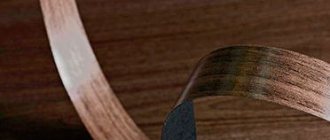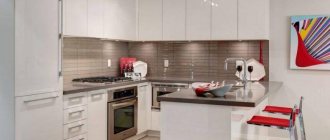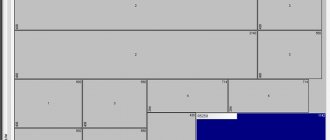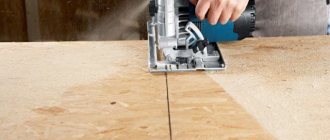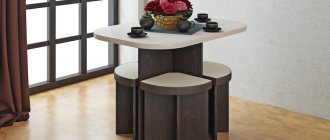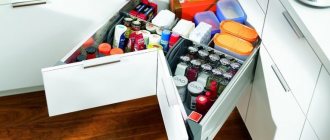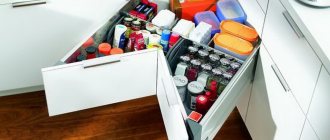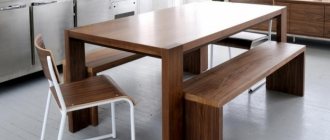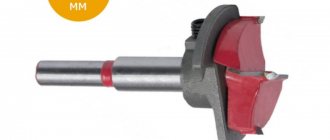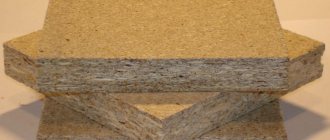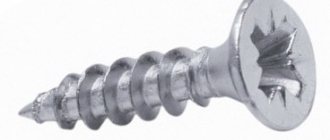Why do you need an edge?
To more clearly understand why you need to use furniture edges, just imagine a sawn chipboard. Due to the peculiarities of its forming composition, the cutting edges are uneven and sharp and can quickly collapse under the influence of external factors. Therefore, they need to be hidden under an additional smooth surface.
The functionality of furniture edges can be divided into:
- decorative component - to give the furniture product a more presentable appearance;
- barrier function - as a barrier to dirt and moisture getting inside the slab.
As protection, the edge also acts in the opposite direction - to protect a person from sharp edges and harmful substances evaporated into the atmosphere from chipboard, which are used in its manufacture.
Common Mistakes
The most common mistakes made by inexperienced craftsmen include:
- Bubble formation. Occurs due to weak heating of the adhesive base or poor pressing of the edge to the part. You will have to reheat it with the iron and press it more carefully.
- Edge offset. It is important to eliminate this defect quickly by returning the part to its place. Otherwise, you will have to tear off and glue a new piece.
- There were pieces of dried glue left on the furniture. The adhesive must be removed while it is hot, before it dries and hardens. This is done with gloves to avoid damaging your hands.
Hardened glue is removed with sandpaper or solvent. It is important to choose the appropriate remedy.
Tip: edging is necessary even for invisible areas of furniture - it will protect the chipboard from absorbing moisture and deforming the material.
Types of furniture edges and their characteristics
To determine the characteristics of the edging, you can take several parameters: composition, size, thickness and appearance. When assembling furniture, you need to take them into account in order to choose the most suitable option for yourself from any price category. Let's take a closer look at each popular type of edging.
Paper or melamine edges
Self-adhesive melamine edging for chipboard is made on the basis of one or two paper layers. This cladding could not have lasted even a few days if it had not been impregnated with a special melamine compound to give it strength. On the outside, as a protection against abrasion, it is coated with varnish, and on the inside, with an adhesive substance to create a basis for adhesion of the edge to the end surface.
Melamine edge with adhesive applied.
The most common material in household interiors today is melamine edging of furniture. This is explained by several reasons:
- the cheapest manufacturing method of all, which also determines its lowest price on the market;
- the ability to work with such edging is available even to a non-professional - you can bring the glue to the desired temperature with your own hands using any heating device;
- a wide variety of colors and patterns.
Despite all the advantages, paper edges with glue applied also have major disadvantages. Although the small thickness makes it easier to adhere to the curves of the surface, at the same time it significantly reduces the wear resistance parameters. Any impact from the outside leads to damage. Therefore, at home, such an edge, for example, is completely unsuitable for the baseboard of a table top.
PVC
The best ratio of low cost and operating properties in the segment of the most popular edgings we are considering. Today everything is made from plastic, everywhere, including it is used as PVC edges for furniture. The modern production process of PVC furniture edges allows you to create surface aesthetics without clearly indicating the plastic material - as a result, it is not difficult to mistake it for natural.
There is a PVC edge of 2 mm or up to 0.4 mm - the choice between them is made depending on what parts it will be attached to, for example, on the tabletop and on the facades, a thicker one will be suitable. In general, for kitchen furniture, it is better not to refuse the service of edging chipboard with plastic, because it is resistant to various chemical compounds, fats, mechanical stress, does not catch fire and has a long service life.
PVC edge 2 mm
PVC edges are widely used for processing edges, but an untrained hand will not cope as quickly as we would like. The thing is that the self-adhesive polymer is attached to the end of the edge product using glue on the back side, which melts at a certain temperature. If it is not followed, the PVC will blur. One more nuance - you need to make very even cuts, and this is basically only possible with a special edger for processing laminated chipboards; only it will efficiently cope with attaching a poorly bending plastic edge to chipboard products.
Most often in the Russian market they give preference to the plastic edge of the German one. Rehau edgebanding is varied in terms of decors, colors and widths. The edging is also suitable for the standard 16 mm Rehau laminated chipboard for the manufacture of custom-made interior items. In addition, among the manufacturers of high-quality PVC edges, Egger and Kronaplast are distinguished. The Austrian edge "Egger" is characterized, among other things, by excellent performance parameters.
Made from ABS plastic
Unlike PVC and paper edges, ABS plastic is practically devoid of such critical disadvantages as the presence of harmful toxic substances and low performance characteristics. The obvious advantages of ABS plastic include good flexibility in work, as well as a very wide range of colors and shades.
However, durability, the highest percentage of strength among other edges, impact resistance and environmental friendliness to the highest standards leave their mark on the price of ABS tape - not everyone can afford it. Therefore, ABS edging and furniture with such edging are produced only in factory conditions.
Veneer edge
Another expensive type of end edge, which is very difficult to handle on your own. Veneer is made from solid wood in the form of cut strips and is used only for edging veneered furniture.
Acrylic edge or 3d
The main feature of acrylic edge is the outer transparent layer. It gives a voluminous, so-called 3D effect to the graphics, which are applied to the base of the tape. This is why 3D edge stands out so much from the rest and is used to create designer furniture.
But for all its unusualness, 3d edge or acrylic edge with a volumetric image PMMA 3d, as it is also called, has a very durable condition, and it is not easy to damage even under strong mechanical stress. Accordingly, the price for such edging will not be the cheapest.
Edge for table tops
For the edge of the kitchen set, you can choose any of the cladding presented above. The main thing to consider is that the edges on chipboard for the kitchen should have a wide range of colors and affordable prices.
The kitchen is a special place in the house; there is always an increased level of pollution and fumes, so the countertop must be constantly carefully processed. An alternative option for the table could be an aluminum edge, which is a very rigid material, and therefore maintains the integrity of the tabletop and protects it from heat from a nearby stove.
You can choose aluminum edges carefully, since their range is now very large. Aluminum edging comes in heights from 28 to 38 mm, and the type of coating is matte or glossy. But you won’t be able to work with it yourself - you need an edge banding machine to correctly apply and cut the material. Few people have one of their own.
Edge thickness
To get the maximum effect from using edging, it is better to order an edging service from professional craftsmen, who will also tell you how to set up the lining process yourself. But first you need to decide on which parts the edging will be applied, and what thickness. Typically, areas visible to the eye are treated with a 2 mm thick tape, and internal surfaces that are less exposed to mechanical stress are treated with a thinner one, for example, 0.4 or 1 mm. The thicker the edge, the greater the difference in the price of the master’s work.
How to stick it yourself
For work you will need a sharp knife, gloves, glue or a heating device, depending on the selected edge parts. You also need to stock up on a rag or roller to press the parts together.
See also
Instructions on how and with what you can glue a denture at home
Using an iron or hair dryer
The melamine and PVC edges are coated with hot-melt adhesive, which becomes sticky when heated. To work with such products, you need an iron or a hair dryer. The surface on which the edge is glued is installed horizontally. Cut a piece of material 2-3 centimeters longer than the length of the cut. Set the iron to mode 2 (“Silk”) and put on a protective cover (cover the sole with a cloth if there is none).
Run the iron along the edge, melting the glue. It is better to start work from the middle and move one by one to the edges of the part. Do not press too hard on the sole so as not to move the edge and squeeze out the glue. After the glue has melted along the entire edge, the iron is removed and the part is pressed with a rag, ensuring a tight connection.
The edges are cut close to the end with a sharp knife. If the edge is wider than the part, it must be cut lengthwise. Use a knife and a metal ruler. For PVC it is better to use a manual milling machine; melamine can be easily cut with a knife. The cut edges are smoothed with sandpaper to remove burrs.
Sticking tapes without glue
Experts consider non-self-adhesive edges more convenient and reliable. You need to purchase glue that is recommended for this material and follow the instructions exactly.
The technology is simple:
- apply glue without excess to the cut and edge;
- wait the recommended time (if required in the instructions);
- carefully combine the parts;
- Using a roller or folded cloth, press the edge firmly against the edge of the furniture;
- Any leaked glue is quickly removed so that you don’t have to use a solvent.
The parts must be pressed tightly and ironed with a cloth until they stick together to prevent bubbles from forming. After completion, remove the glue particles, trim the ends, and sand the edge with sandpaper.
PVC profiles for finishing edges of furniture
The type of edge fastening can also be overhead or mortise. A PVC profile is mechanically connected, which stands out from the background of a regular edge with a more durable coating. There are two types of such profiles.
T-shaped PVC profile U-shaped PVC profile
U-shaped invoice
Used by both professionals and home workers. It is placed on the cut of the slab and secured with glue applied to the inside. A rigid U-shaped edge is difficult to mount on curved surfaces - this is the main difficulty of working with it. But there is also a flexible profile of this type, but its wear-resistant characteristics are much lower.
T-shaped mortise
It is considered a very reliable edge material. It has spikes that are inserted into a specially created recess in the center of the edge of the slab. To cut into this profile, a rubber hammer is used; it drives the edge into the grooves.
Advantages
Overlay and mortise edges do a good job of masking visible flaws in the ends: they hide all the irregularities, chips and cut inaccuracies. A wide range of profile colors allows you to successfully integrate them into interior design.
